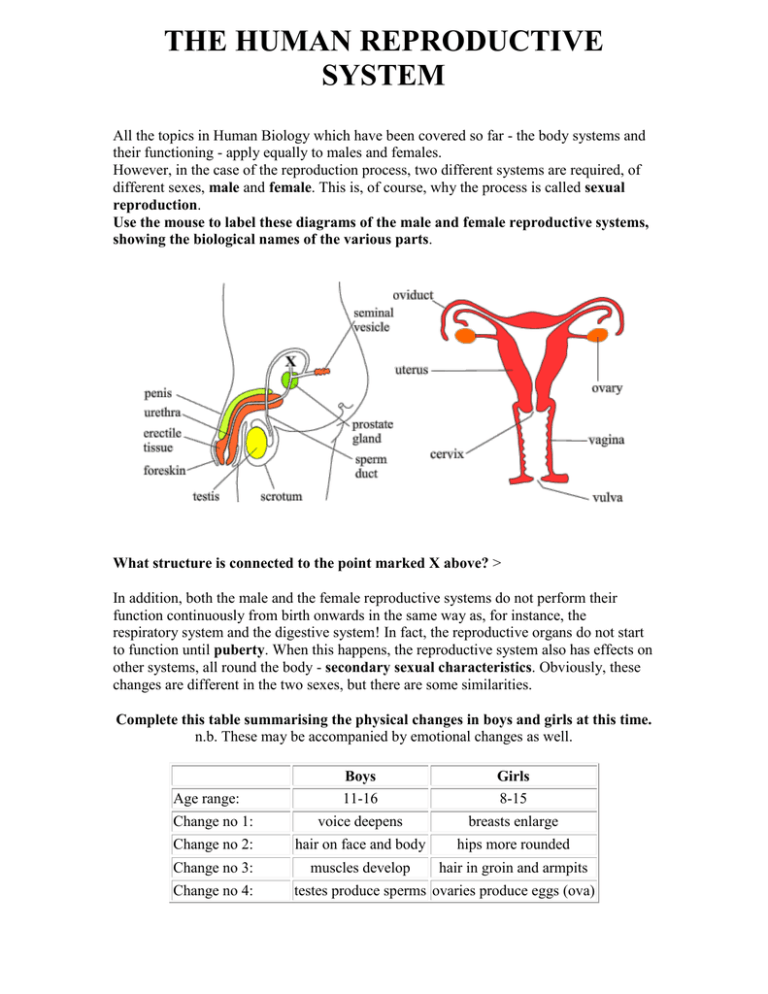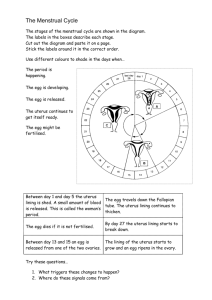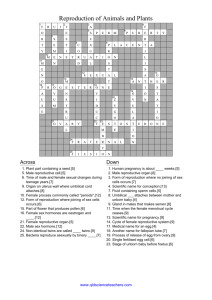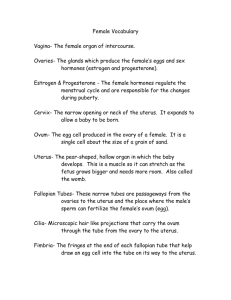THE HUMAN REPRODUCTIVE SYSTEM
advertisement

THE HUMAN REPRODUCTIVE SYSTEM All the topics in Human Biology which have been covered so far - the body systems and their functioning - apply equally to males and females. However, in the case of the reproduction process, two different systems are required, of different sexes, male and female. This is, of course, why the process is called sexual reproduction. Use the mouse to label these diagrams of the male and female reproductive systems, showing the biological names of the various parts. What structure is connected to the point marked X above? > bladder In addition, both the male and the female reproductive systems do not perform their function continuously from birth onwards in the same way as, for instance, the respiratory system and the digestive system! In fact, the reproductive organs do not start to function until puberty. When this happens, the reproductive system also has effects on other systems, all round the body - secondary sexual characteristics. Obviously, these changes are different in the two sexes, but there are some similarities. Complete this table summarising the physical changes in boys and girls at this time. n.b. These may be accompanied by emotional changes as well. Boys 11-16 Girls 8-15 Change no 1: voice deepens breasts enlarge Change no 2: hair on face and body hips more rounded Change no 3: muscles develop hair in groin and armpits Age range: Change no 4: testes produce sperms ovaries produce eggs (ova) Changes caused by hormone called: testosterone oestrogen produced by: testes ovaries Most of the changes at puberty can be seen as preparation for the process of reproduction, and for the eventual role of parenthood. THE MENSTRUAL CYCLE From puberty ( age roughly 8 - 15 ) until the menopause (age roughly 45 - 55 years), the female reproductive system normally goes through a series of regular changes which are called the menstruan cycle, because it is repeated month after month. In fact, the cycle normally lasts about 28 days, although there is some variation from one woman to another. Most of the changes involve the buildup of the lining of the uterus, to coincide with the release of an egg (ovulation) so as to provide an environment to accept a fertilised egg, followed by the breakdown of this tissue if the egg is not fertilised. When the lining of the uterus is got rid of, it results in a flow of blood and tissue. This phase, which lasts only about 4-5 days, is called menstruation. Counting from the first day of bleeding, an egg is normally released at about day 14 (i.e. in the middle of the cycle), although there is some variation, and the cycle length may also vary. Hormonal regulation of the menstrual cycle After menstruation, follicle stimulating hormone (FSH), from the pituitary gland, causes a follicle in the ovary to develop, and before releasing the egg the follicle produces several oestrogen hormones. Under the influence of oestrogens, the lining of the uterus gradually grows thicker. After ovulation, rising levels of progesterone from the corpus luteum (remains of the follicle) support this lining, and cause blood vessels in it to become more developed (vascularisation) - in preparation to receive an egg, if it is fertilised. As the production of progesterone decreases in the next few days, support for the thickened uterine lining is lost, and eventually menstruation occurs, usually on the 28th day. SEXUAL INTERCOURSE This is also called making love, because it is a very intimate act between a man and a woman, and it should be a pleasurable experience for both. In the process, a liquid called semen, containing sperms, passes out of the end of the man's penis - a process called ejaculation - and these may be deposited inside the woman's vagina. CONCEPTION In order for a woman to become pregnant, several events must occur. - Sperms must swim through the cervix, through the uterus and along the Fallopian tube, and meet an egg which has just been released from the ovary, and which is travelling in the opposite direction along the Fallopian tube. - One sperm must enter the egg and both cells must join together, so that their nuclei fuse - the process of fertilisation. - The fertilised egg (zygote) then starts to divide to produce more cells, but the ball of cells produced must become attached to the lining of the uterus (implantation), in order to develop further. It will also continue to produce progesterone which stabilises conditions inside the uterus until birth. Use the mouse to identify the regions within the female reproductive system where Ejaculation, Fertilisation, and Implantation may occur.







